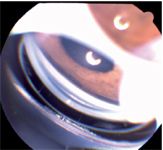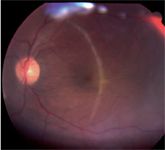Article
Staggered approach useful
Staggered management- consisting of medical therapy, argon laser, and cyclopexy - is beneficial in patients with cyclodialysis cleft.

Cyclodialysis cleft, an uncommon diagnosis, is the detachment of the ciliary body from its insertion in the scleral spur, which produces communication between the anterior chamber and the choroidal space. This results in decreased visual acuity that is compromised by hypotony maculopathy, said Dr. Perez, a staff member of the Cornea Department at the Salvador Hospital, Santiago, Chile.
Dr. Perez and colleagues conducted a retrospective study in Santiago, Chile of the functional visual outcome and the normalization rate of the IOP of a staggered approach to the management of cyclodialysis cleft. The primary study outcomes were the visual acuity and the IOP, he explained.
Staggered management of the condition as used in this study consisted of an initial medical approach of application of topical atropine 1% every 8 hours and prednisone 1% every 4 hours. Medical therapy was followed by argon laser application directly to the cleft and direct cyclopexy in cases that were refractory to the previous treatment.
The patient assessment included determination of the cause of the cleft, the visual acuity and IOP before and after treatment, treatments, and the evolution time of the cleft (i.e., the time from the incident that caused the cleft to the time of presentation for treatment).

Some patients required more than one session of laser treatment for the cleft to resolve.
Almost all patients had improvement in IOP and VA, Dr. Perez said. No patients had a response only to medical therapy. In two patients (28%), medical therapy and argon laser therapy was enough to seal the cleft; however, five patients (72%) required a surgical resolution via direct cyclopexy.

The improvements in the two parameters were statistically significant (p < 0.05 for both comparisons).





